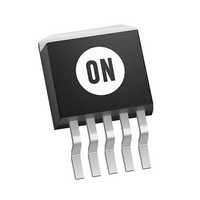LM2595DSADJR4G ON Semiconductor, LM2595DSADJR4G Datasheet - Page 14

LM2595DSADJR4G
Manufacturer Part Number
LM2595DSADJR4G
Description
IC REG SW 1A STEPDOWN D2PAK-5
Manufacturer
ON Semiconductor
Type
Step-Down (Buck)r
Datasheet
1.LM2595DSADJR4G.pdf
(25 pages)
Specifications of LM2595DSADJR4G
Internal Switch(s)
Yes
Synchronous Rectifier
No
Number Of Outputs
1
Voltage - Output
1.2 ~ 37 V
Current - Output
1A
Frequency - Switching
150kHz
Voltage - Input
4.5 ~ 40 V
Operating Temperature
-40°C ~ 125°C
Mounting Type
Surface Mount
Package / Case
D²Pak, TO-263 (5 leads + tab)
Output Voltage
1.23 V to 37 V
Output Current
1 A
Input Voltage
4.75 V to 40 V
Switching Frequency
150 KHz
Operating Temperature Range
- 40 C to + 125 C
Mounting Style
SMD/SMT
Duty Cycle (max)
95 %
Lead Free Status / RoHS Status
Lead free / RoHS Compliant
Power - Output
-
Lead Free Status / Rohs Status
Lead free / RoHS Compliant
Available stocks
Company
Part Number
Manufacturer
Quantity
Price
Company:
Part Number:
LM2595DSADJR4G
Manufacturer:
ON Semiconductor
Quantity:
8
EXTERNAL COMPONENTS
Input Capacitor (C
The Input Capacitor Should Have a Low ESR
ESR (Equivalent Series Resistance) aluminium or solid
tantalum bypass capacitor is needed between the input pin
and the ground pin, to prevent large voltage transients from
appearing at the input. It must be located near the regulator
and use short leads. With most electrolytic capacitors, the
capacitance value decreases and the ESR increases with
lower temperatures. For reliable operation in temperatures
below −25°C larger values of the input capacitor may be
needed. Also paralleling a ceramic or solid tantalum
capacitor will increase the regulator stability at cold
temperatures.
RMS Current Rating of C
current rating. Capacitors that are physically large and have
large surface area will typically have higher RMS current
ratings. For a given capacitor value, a higher voltage
electrolytic capacitor will be physically larger than a lower
voltage capacitor, and thus be able to dissipate more heat to
the surrounding air, and therefore will have a higher RMS
current rating. The consequence of operating an electrolytic
capacitor beyond the RMS current rating is a shortened
operating life. In order to assure maximum capacitor
operating lifetime, the capacitor’s RMS ripple current rating
should be:
where d is the duty cycle, for a buck regulator
Output Capacitor (C
output capacitors are recommended. An output capacitor
has two main functions: it filters the output and provides
and d +
For stable operation of the switch mode converter a low
The important parameter of the input capacitor is the RMS
For low output ripple voltage and good stability, low ESR
t on
T
+
|V out | ) V
I
in
rms
|V out |
)
out
d +
> 1.2 x d x I
)
in
t on
T
in
+
for a buck * boost regulator.
V out
V in
Load
APPLICATION INFORMATION
http://onsemi.com
14
regulator loop stability. The ESR of the output capacitor and
the peak−to−peak value of the inductor ripple current are the
main factors contributing to the output ripple voltage value.
Standard aluminium electrolytics could be adequate for
some applications but for quality design, low ESR types are
recommended.
related to many factors such as the capacitance value, the
voltage rating, the physical size and the type of construction.
In most cases, the higher voltage electrolytic capacitors have
lower ESR value. Often capacitors with much higher
voltage ratings may be needed to provide low ESR values
that, are required for low output ripple voltage.
Feedfoward Capacitor
(Adjustable Output Voltage Version)
loop and increases the phase margin for better loop stability.
For C
The Output Capacitor Requires an ESR Value
That Has an Upper and Lower Limit
output ripple voltage, typically 1% to 2% of the output
voltage. But if the selected capacitor’s ESR is extremely low
(below 0.05 W), there is a possibility of an unstable feedback
loop, resulting in oscillation at the output. This situation can
occur when a tantalum capacitor, that can have a very low
ESR, is used as the only output capacitor.
At Low Temperatures, Put in Parallel Aluminium
Electrolytic Capacitors with Tantalum Capacitors
temperatures below −25°C. The ESR rises dramatically at
cold temperatures and typically rises 3 times at −25°C and
as much as 10 times at −40°C. Solid tantalum capacitors
have much better ESR spec at cold temperatures and are
recommended for temperatures below −25°C. They can be
also used in parallel with aluminium electrolytics. The value
of the tantalum capacitor should be about 10% or 20% of the
total capacitance. The output capacitor should have at least
50% higher RMS ripple current rating at 150 kHz than the
peak−to−peak inductor ripple current.
An aluminium electrolytic capacitor’s ESR value is
This capacitor adds lead compensation to the feedback
As mentioned above, a low ESR value is needed for low
Electrolytic capacitors are not recommended for
FF
selection, see the design procedure section.











